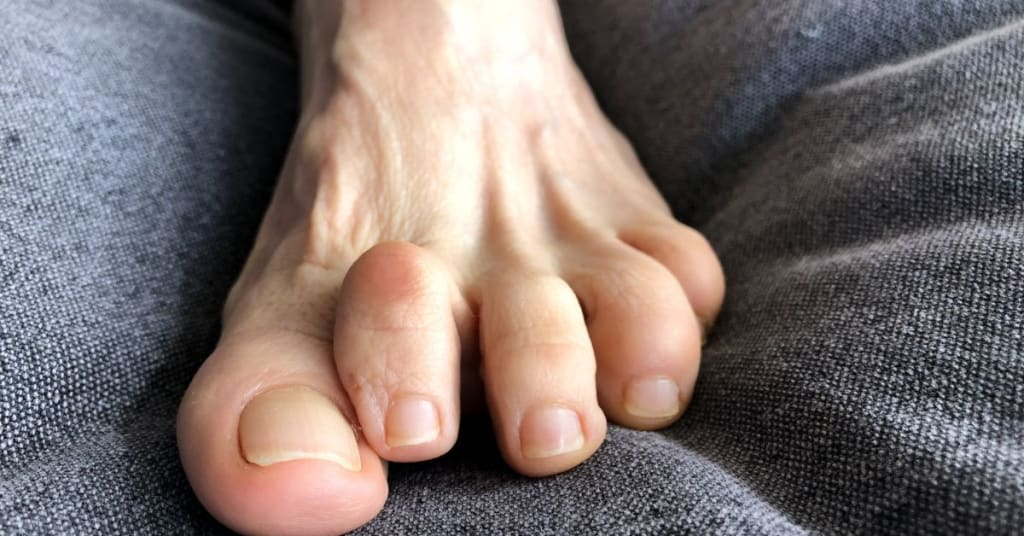How to Get Rid of a Hammer Toe: Everything You’d Like to Know
A hammer toe is a malformation in which your toe bends or curls downward rather than forward. Any toe on your foot can be affected by this condition, but it usually happens to the second or third toe. A hammer toe may be present at birth, although it commonly develops over time as a result of arthritis or wearing uncomfortable shoes. Though, this problem is usually curable.

Causes
In the middle and bottom of your toe, there are two joints that allow it to bend. A hammer toe happens when the middle joint flexes or bends downward.
Common causes of this include:
- arthritis
- a traumatic toe injury
- wearing shoes that don’t fit properly
- an unusually high foot arch
- pressure from a bunion, which is when your big toe points inward toward your second toe
- tightened ligaments or tendons in the foot
Damage to your spinal cord or peripheral nerves may cause all of your toes to curl downward.
Signs and symptoms
When you walk, a hammer toe produces discomfort and may hurt if you attempt to extend or move the affected toe or those nearby.
Hammer toe symptoms include:
- difficulty walking
- corns or calluses
- a toe that bends downward
- claw-like toes
- inability to flex your foot or wiggle your toes
If you experience any of these symptoms, contact your orthopedic surgeon or podiatrist right away.
Non-invasive treatment for a hammer toe
Wearing correct-fitting shoes can help you fix a hammer toe caused by improper footwear. If your high arch caused the problem, wearing toe pads or insoles in your shoes may help to correct it. These patches reduce pain and improve the appearance of your toe by altering its position.
Bunions and corn are typically treated with over-the-counter (OTC) cushions, pads, or medicines. However, if they cause pain or deformity in your toes, your doctor may decide to surgically remove them.
Avoid getting blisters on your toes. Blisters that are popped can cause pain and infection. To ease discomfort and keep blisters from pressing on the inside of your shoes, use over-the-counter balms and cushions.
Stretching your toes gently might also help reduce pain and realign the damaged toe.
Hammer toe surgery
If you are unable to bend your toe, the only way to regain movement is through surgery. Hammer toe surgery can correct your tendons and joints, reposition your toe, and remove misshapen or injured bone.
Hammer toe surgery is typically performed on an outpatient basis. That implies you can leave on the same day you get it. You may be given general anesthesia, which will put you to sleep for the duration of the procedure. Your doctor may decide not to use general anesthesia and instead employ numbing drugs so that you don't feel anything being done to your foot.
The operation you have will be determined by the severity of your hammer toe. The surgeon may be able to do a tendon transfer if the toe is still relatively flexible. This entails rerouting tendons from the toe's bottom to the top, where it is bent. The redirected tendons can then aid in toe straightening.
The surgeon has two alternatives if your hammer toe has become fixed or stiff: joint excision or fusion.
Joint resection
An incision is created on the top of the toe to reach the ligaments and tendons underneath during joint resection. To help straighten the toe, the ligaments and tendons may be severed. To allow the toe to fully stretch, the end of one bone is removed. Small metal pins or rods are frequently used to hold the toe straight while it heals. The surgeon will remove the pins within a month after the surgery.
Fusion
Ligaments and tendons are also severed during fusion to straighten the toe. However, in this treatment, the ends of the two bones that create the problematic joint are removed to straighten the toe. While the ends of the bone heal or fuse together, pins or screws are used.
Cost
If the issue is judged medically essential, a hammer toe is frequently covered by insurance or Medicare. Your doctor may determine that the procedure is medically necessary if:
- You are in pain.
- You are unbalanced because of your hammer toe.
- Your whole foot health is being harmed by this condition.
Insurance is unlikely to pay hammer toe correction for simply cosmetic reasons. Hammer toe surgery costs around $4,265 out of pocket, according to the Healthcare Bluebook.
Recovery
It may take several weeks to fully recuperate from hammer toe surgery. The type of operation will decide the timeframe. During your recovery, you may be given a customized shoe to help you walk and maintain your balance. Crutches or a walker may also be required.
During the first several weeks after surgery, you should aim to keep your foot elevated most of the time. This will relieve stress on the toe and allow it to heal. Swelling around the toe is to be expected. The swelling could linger up to a year, although the pain should go away soon after the surgery. If you have pins or screws in your toe, they may be removed a few weeks after surgery.
You will be unable to drive for several weeks after the surgery. You should ask your doctor about any other limitations on activities. Also, avoid submerging your foot until the pins or screws have been removed.
Complications
All surgeries have a risk of complications, including infection, nerve damage, blood clot formation, or a bad reaction to the anesthesia.
The chance of your toe curling up again is one of the specific complications of hammer toe surgery. This is, however, exceptional. It is also uncommon for the bones to fail to mend adequately following a fusion treatment.
About the Creator
Amelia Grant
I am journalist, and blogger.






Comments
There are no comments for this story
Be the first to respond and start the conversation.